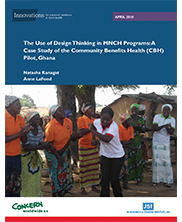Responding to growing interest among designers, global health practitioners, and funders in understanding the potential benefits of applying design thinking methods and tools to solving complex social problems, the Innovations for Maternal, Newborn, and Child Health (MNCH) Initiative (Innovations) developed and piloted innovative interventions to address common barriers to improving the effectiveness of basic MNCH health services in low-resource settings.
Central to the initiative’s overall strategy was experimentation and learning related to the application of “design thinking,” a form of inquiry that is applied in the conceptual stages of a planning process and subsequent stages of program or product development. A fundamental rationale for the use of design thinking is that it provides important insights into user experience, needs, and desires and helps to translate these insights into tailored interventions or products, increasing the likelihood of user adoption and reducing the risk of intervention failure. In spite of increased reports of the use of design thinking in developing country settings, there is little systematically recorded evidence of the value of these approaches in the form of in-depth documentation or formal evaluations that link the application of design thinking to health program performance or health outcomes. Moreover, there are few validated metrics to assess the effect of design thinking.
This case study focuses on the use of design thinking in the Community Benefits Health (CBH) pilot that aimed to improve MNCH-related behaviors among women of childbearing age by influencing community-wide social norms over the two-year pilot period in select Ghanaian communities. The behavior change interventions included a behavior-change messaging strategy and an innovative, community-wide nonmonetary incentive scheme.
The research design used a mixed-method, comparative case study approach. We constructed research propositions to describe and explain the application and influence of design thinking in the CBH pilot and focused our research using the constructs of fit, uptake, buy-in, ownership, and the effectiveness of the CBH model. We refined these propositions over time and, as data emerged, constructed a theoretical pathway to illustrate the influence of design thinking on the CBH intervention. The in-depth case study methodology was intentionally designed to be exploratory and analytical but not evaluative.
Natasha Kanagat and Anne LaFond, JSI Research & Training Institute, Inc. 2018.


